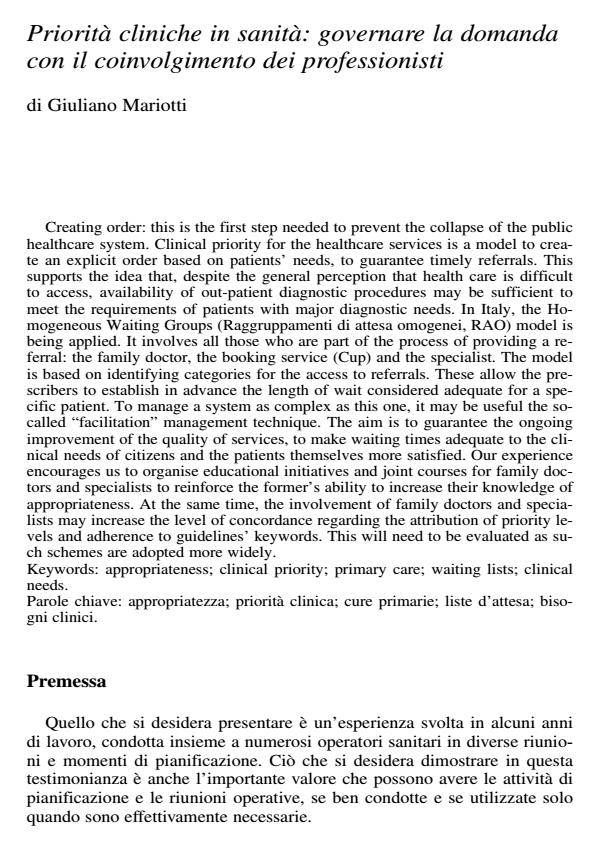Priorità cliniche in sanità: governare la domanda con il coinvolgimento dei professionisti
Titolo Rivista SALUTE E SOCIETÀ
Autori/Curatori Giuliano Mariotti
Anno di pubblicazione 2009 Fascicolo 2009/Suppl. 1 Lingua Italiano
Numero pagine 12 P. 166-177 Dimensione file 1776 KB
DOI 10.3280/SES2009-SU1014
Il DOI è il codice a barre della proprietà intellettuale: per saperne di più
clicca qui
Qui sotto puoi vedere in anteprima la prima pagina di questo articolo.
Se questo articolo ti interessa, lo puoi acquistare (e scaricare in formato pdf) seguendo le facili indicazioni per acquistare il download credit. Acquista Download Credits per scaricare questo Articolo in formato PDF

FrancoAngeli è membro della Publishers International Linking Association, Inc (PILA)associazione indipendente e non profit per facilitare (attraverso i servizi tecnologici implementati da CrossRef.org) l’accesso degli studiosi ai contenuti digitali nelle pubblicazioni professionali e scientifiche
Priorità cliniche in sanità: governare la domanda con il coinvolgimento dei professionisti - Creating order: this is the first step needed to prevent the collapse of the public healthcare system. Clinical priority for the healthcare services is a model to create an explicit order based on patients’ needs, to guarantee timely referrals. This supports the idea that, despite the general perception that health care is difficult to access, availability of out-patient diagnostic procedures may be sufficient to meet the requirements of patients with major diagnostic needs. In Italy, the Homogeneous Waiting Groups (Raggruppamenti di attesa omogenei, RAO) model is being applied. It involves all those who are part of the process of providing a referral: the family doctor, the booking service (Cup) and the specialist. The model is based on identifying categories for the access to referrals. These allow the prescribers to establish in advance the length of wait considered adequate for a specific patient. To manage a system as complex as this one, it may be useful the socalled "facilitation" management technique. The aim is to guarantee the ongoing improvement of the quality of services, to make waiting times adequate to the clinical needs of citizens and the patients themselves more satisfied. Our experience encourages us to organise educational initiatives and joint courses for family doctors and specialists to reinforce the former’s ability to increase their knowledge of appropriateness. At the same time, the involvement of family doctors and specialists may increase the level of concordance regarding the attribution of priority levels and adherence to guidelines’ keywords. This will need to be evaluated as such schemes are adopted more widely.
Keywords: appropriateness; clinical priority; primary care; waiting lists; clinical needs.;
Giuliano Mariotti, Priorità cliniche in sanità: governare la domanda con il coinvolgimento dei professionisti in "SALUTE E SOCIETÀ" Suppl. 1/2009, pp 166-177, DOI: 10.3280/SES2009-SU1014